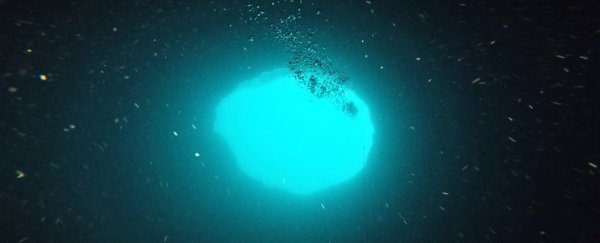When sinkholes open up on land, it's terrifying. In an instant, they can swallow whatever's on top of them, whether that's a road, a landscape, or an ancient creature destined to not see the light of day again for millennia.
Sinkholes aren't just confined to land, though. A similar phenomenon also takes place in the ocean, creating mysterious 'blue holes' that plummet into dark, watery nothingness. Distinct from the underwater caverns of cenotes, which exist under land, blue holes only open up in the sea, making them much more difficult to explore and understand.
Nonetheless, they represent a valuable opportunity for scientists seeking to learn more about what kind of life-forms and underwater conditions occur in these unique marine formations.
As part of an ongoing three-year research project, a multi-institutional team of scientists is set to embark next month to explore a blue hole called 'Green Banana' situated on the continental shelf off the coast of Florida.
Comprising researchers from Mote Marine Laboratory, Florida Atlantic University, the Georgia Institute of Technology, and the US Geological Society, the NOAA-sponsored project will deploy divers and monitoring equipment into Green Banana, which opens up 47 metres (155 ft) below the sea surface, extending to a depth of about 130 metres (425 ft).
The aim is to examine what kind of microbes live in the blue hole, measure nutrient levels in the underwater column, and assess whether the sinkhole is somehow connected to Florida's groundwater system adjacent to the Gulf of Mexico.
After August's dive, another is scheduled to take place next year, following up on research expeditions last year to investigate another Florida blue hole, called Amberjack Hole, which is significantly smaller than Green Banana – with a rim at 34 metres (113 ft) below the ocean surface, and extending down for about 72 metres (237 ft) below that.
"Blue holes are diverse biological communities full of marine life, including corals, sponges, mollusks, sea turtles, sharks, and more," the NOAA explains.
"The seawater chemistry in the holes is unique and appears to interact with groundwater and possibly aquifer layers. This link contributes to the knowledge of carbon cycling between surface and groundwater."
It might be a while before we hear more on the Green Banana expedition, but samples recovered at Amberjack Hole have already shown large amounts of dissolved inorganic carbon in the water, which the researchers say contributes to the carbon cycle, possibly as a food source for microbial populations.
There were also signs of nutrient flux travelling upwards in the sinkhole, meaning that some food sources could eventually emerge from the blue hole, even while other creatures – including deceased sawfish discovered by the researchers – slowly sink to the bottom.
Last year's dives also isolated signals of groundwater in the blue hole, finding isotopes of radium and radon, which suggest there could be an underwater connection linking the Floridan Aquifer to the Gulf of Mexico.
Whether the Green Banana can corroborate that signal remains to be seen, but whatever the researchers find, it's bound to help us better understand what goes on inside these strange sinkholes hidden below the surface.
